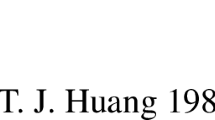Abstract
Three experiments investigating first-grade children's comprehension, of referentially ambiguous messages are reported. In the first one children were shown to interpret a literally ambiguous message by means of the strategy based on the conversational Maxim of Antecedent rather than that based on the more appropriate Maxim of Quantity. The results of the second experiment suggest that the Maxim of Quantity can be used by children, provided the situation is quite simple; they also suggest that after having used such a maxim in a simple situation, children can apply it in a more complex situation. This generalization to new situations, however, is not a mere “perseveration” since, as shown in the third experiment, children can adjust their comprehension strategy to the situation requirements. The results are discussed with reference to the recent proposals on referential ambiguity and children communication failures.
Similar content being viewed by others
References
Asher, S. (1976). Children's ability to appraise their own and another person's communication performance.Developmental Psychology, 12, 24–34.
Beaudichon, J. (1978). Structure and efficiency in child communication.International Journal of Psycholinguistics, 5, 59–73.
Clark, H. H., & Carlson, T. B. (1983). Context for comprehension. In J. Lang & A. Baddeley (Eds.),Attention and performance (Vol. 9), Hillsdale, New Jersey: Erlbaum.
Clark, H. H., & Haviland, S. E. (1977). Comprehension and the given-new contract. In R. Freedle (Ed.),Discourse production and comprehension. Hillsdale, New Jersey: Erlbaum.
Clark, H. H., & Marshall, C. R. (1981). Definite reference and mutual knowledge. In A. K. Joshi, B. L. Webber, & I. A. Sag (Eds.),Elements of discourse understanding. Cambridge: Cambridge University Press.
Deutsch, W., & Pechmann, Th. (1982). Social interaction and the development of definite description.Cognition, 11, 159–184.
Dickson, W. P. (1981).Children's oral communication skills. New York: Academic Press.
Flavell, J. C., Bothkin, T., Fry, C. L., Wright, J. C., & Jarvis, P. E. (1968).The development of role-taking and communication skills in children. New York: Wiley.
Ford, W., & Olson, D. (1975). The elaboration of the noun phrase in children's descriptions.Journal of Experimental Child Psychology, 19, 371–382.
Glucksberg, S., Krauss, R. M., & Weisberg, R. (1966). Referential communication in nursery school children: Method and some preliminary findings.Journal of Experimental Child Psychology, 3, 333–342.
Grice, H. P. (1975). Logic and conversation. In P. Cole & J. Morgan (Eds.),Syntax and semantics (Vol. 3),Speech acts. New York: Academic Press.
Jackson, S., & Jacobs, S., (1982). Ambiguity and implicature in children's discourse comprehension.Journal of Child Language, 9, 209–216.
Krauss, R. M., & Glucksberg, S. (1977). Social and nonsocial speech,Scientific American, 232(2), 100–105.
Patterson, C. J., & Kister, M. C. (1981). The development of listener skills for referential communication. In W. P. Dickson (Ed.),Children's oral communication skills. New York: Academic Press.
Patterson, C. J., & Massad, C. M. (1980). Facilitating referential communication among children: The listener as teacher.Journal of Experimental Child Psychology, 29, 357–370.
Piaget, J. (1923).Le langage et la pensée chez l'enfant. Neuchatel: Delachaux et Niestlé.
Roberts, R., & Patterson, C. (1983). Perspective taking and referential communication: The question of correspondence reconsidered.Child Development, 54, 1005–1014.
Robinson, E. J., & Robinson, W. P. (1976). The young child's understanding of communication.Developmental Psychology, 12, 328–333.
Van Hekker, S. M. J., Vergeer, M. M., & Harris, P. L. (1980). Ambiguity of reference and listeners' reaction in a naturalistic setting.Journal of Child Language, 7, 555–563.
Whitehurst, G. J., & Sonnenschein S. (1978). Attribute variation leads to contrast failure.Journal of Experimental Child Psychology, 25, 490–504.
Author information
Authors and Affiliations
Rights and permissions
About this article
Cite this article
Surian, L., Job, R. Children's use of conversational rules in a referential communication task. J Psycholinguist Res 16, 369–382 (1987). https://doi.org/10.1007/BF01069289
Accepted:
Issue Date:
DOI: https://doi.org/10.1007/BF01069289




